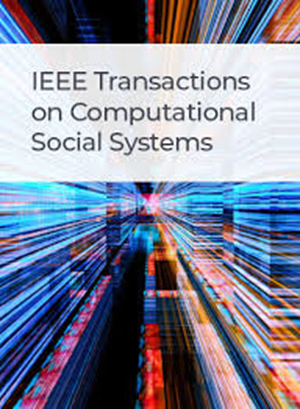DDRec: Dual Denoising Multimodal Graph Recommendation
IF 4.5
2区 计算机科学
Q1 COMPUTER SCIENCE, CYBERNETICS
IEEE Transactions on Computational Social Systems
Pub Date : 2024-11-26
DOI:10.1109/TCSS.2024.3490801
引用次数: 0
Abstract
Multimodal recommendation systems have made significant progress by leveraging graph convolutional networks to integrate user behavior with item content, including images and text. However, these systems still encounter two major challenges: noise edges in interaction graphs and noise in multimodal features of items. Existing works tend to address only one type of noise problem to enhance recommendation performance. This article proposes a new Dual Denoising Multimodal Graph Recommendation (DDRec) model, designed to enhance multimodal recommendation systems by tackling both challenges simultaneously. Specifically, we design two denoising techniques: hard denoising and soft denoising. For noise edges in interaction graphs, the hard denoising method uses preference scores of user nodes and item nodes in different modality interaction graphs as edge weights and prunes edges below a certain threshold to eliminate noise. For noise in multimodal features, the soft denoising method leverages item and item semantic graph information to denoise modal features, thus obtaining modality features related to user preferences. Finally, we employ contrastive learning to compare user and item representations derived from the denoised modality interaction graphs against those from the original graph, ensuring the consistency of nodes across various views. Our comprehensive experiments across four public datasets validate the enhanced performance and effectiveness of the DDRec model.DDRec:双去噪多模态图推荐
多模式推荐系统通过利用图卷积网络将用户行为与项目内容(包括图像和文本)集成在一起,取得了重大进展。然而,这些系统仍然面临两个主要挑战:交互图中的噪声边缘和项目多模态特征中的噪声。现有的工作往往只解决一种类型的噪声问题,以提高推荐性能。本文提出了一种新的双去噪多模态图推荐(DDRec)模型,旨在通过同时解决这两个挑战来增强多模态推荐系统。具体来说,我们设计了两种去噪技术:硬去噪和软去噪。对于交互图中的噪声边,硬去噪方法采用不同模态交互图中用户节点和项目节点的偏好得分作为边权值,将边缘剪到一定阈值以下,消除噪声。对于多模态特征中的噪声,软去噪方法利用物品和物品语义图信息对模态特征进行去噪,从而获得与用户偏好相关的模态特征。最后,我们使用对比学习来比较来自去噪模态交互图的用户和项目表示与来自原始图的用户和项目表示,以确保不同视图中节点的一致性。我们在四个公共数据集上的综合实验验证了DDRec模型的增强性能和有效性。
本文章由计算机程序翻译,如有差异,请以英文原文为准。
求助全文
约1分钟内获得全文
求助全文
来源期刊

IEEE Transactions on Computational Social Systems
Social Sciences-Social Sciences (miscellaneous)
CiteScore
10.00
自引率
20.00%
发文量
316
期刊介绍:
IEEE Transactions on Computational Social Systems focuses on such topics as modeling, simulation, analysis and understanding of social systems from the quantitative and/or computational perspective. "Systems" include man-man, man-machine and machine-machine organizations and adversarial situations as well as social media structures and their dynamics. More specifically, the proposed transactions publishes articles on modeling the dynamics of social systems, methodologies for incorporating and representing socio-cultural and behavioral aspects in computational modeling, analysis of social system behavior and structure, and paradigms for social systems modeling and simulation. The journal also features articles on social network dynamics, social intelligence and cognition, social systems design and architectures, socio-cultural modeling and representation, and computational behavior modeling, and their applications.
 求助内容:
求助内容: 应助结果提醒方式:
应助结果提醒方式:


